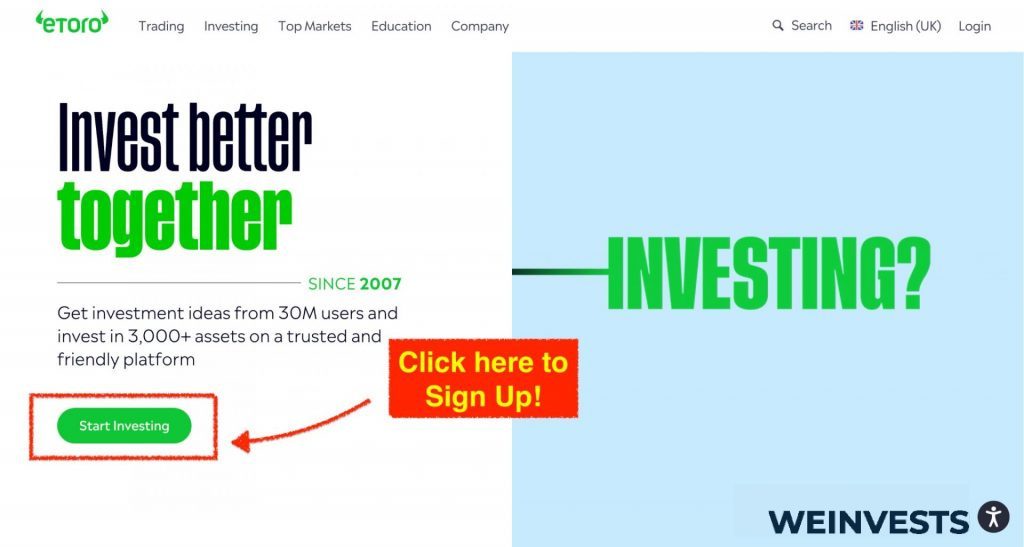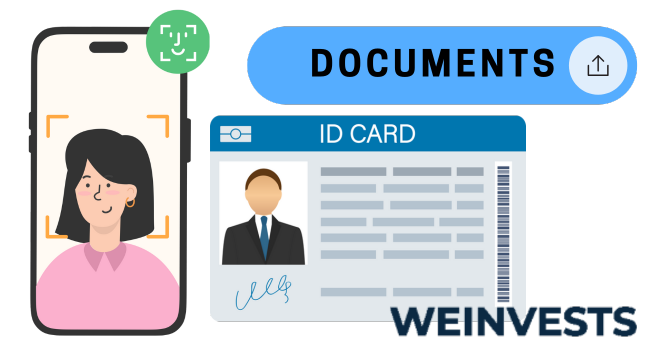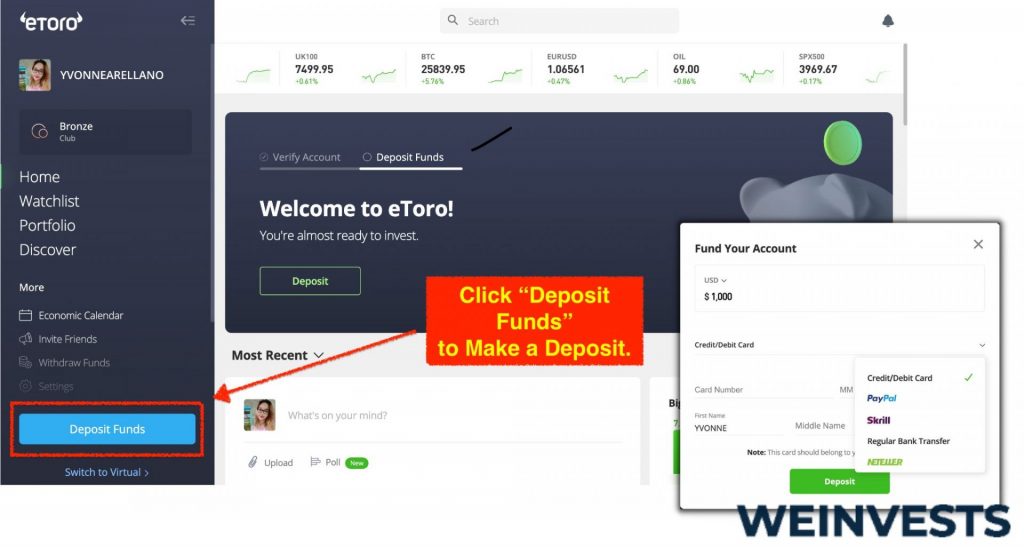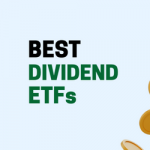This content represents the writer’s opinions and research and is not intended to be taken as financial advice. The information presented is general in nature and may not meet the specific needs of any individual or entity. It is not intended to be relied upon as a professional or financial decision-making tool.
Investing in gold is essential when it comes to effective diversification.
Gold and stocks are inversely correlated. This attribute to gold helps a portfolio that is invested in it maintain a lower volatility level as opposed to an all-stock portfolio or just a mixture of stocks and bonds.
However, it can be expensive for a retail investor to trade, store, and insure physical gold. For this reason, gold ETFs are a very good choice if you’re looking for exposure to that asset.
In this post, we want to present to you the 5 best gold ETFs that you may want to include in your portfolio.
Whatever your intentions are for owning gold, the list below will provide you with large ETFs that have already operated for some time and provide exposure to gold for low expense ratios.
Table of Contents
What are Gold ETFs?
You may already know what ETFs are in general, but let’s cover that briefly before we explain gold ETFs in case you don’t.
An Exchange-Traded Fund or ETF is an investment vehicle (fund) that professionals manage. What makes an ETF different from other funds is that it is listed on stock exchanges and traded like stocks.
When you trade ETF shares, you get partial ownership of the ETF and you’re indirectly the owner of any assets its managers trade through the fund.
ETFs can invest in all kinds of assets and sometimes in multiple ones. For example, some ETFs invest in stocks, others in bonds or commodities, and yet others invest in a combination of them as part of their strategies.
Gold ETFs, now, refer to the ones that invest in just one commodity: gold bullion. When you trade such an ETF, you get partial ownership of physical gold that is stored in vaults.
Before you start going through our list, take a moment to familiarize yourself with the terms below:
- Expense Ratio
This is the percentage of the assets under management an ETF and other funds charge per year. In the case of gold ETFs, the expense ratio reflects the costs associated with storing physical gold, auditing expenses, and management fees.
- SEC 30-Day Yield
This is the 30-day distribution yield of an ETF after expenses.
Gold ETFs generally don’t produce interest or dividends but those that invest in gold mining companies do if some underlying stocks pay dividends.
Top 5 Gold ETFs
SPDR Gold Trust (GLD)
SPDR Gold Trust was created by State Street Global Advisors in November 2004 and is listed on NYSE Arca. As of January 2023, it had $56.6 billion in assets under management.
It was the first US-traded gold ETF and the first ETF listed on a US exchange that was backed by a physical asset. Its goal is to track the LBMA Gold Price index as closely as possible.
Its expense ratio is at 0.4% and its volume of traded shares as of 1/25/2023 was 1,169,675.
As for its performance, the benchmark returned an average of 8.1% per year since the inception of the fund, while the ETF returned one of 7.62%.
Looking at the performance in the last 10 years, the fund’s return was 0.46% and the benchmark’s was 0.9%.
Additionally, a shorter-term look at the last 5-year performance shows that the fund returned an average annual return of 6.53% and the benchmark one of 7.03%.
iShares Gold Trust was created by BlackRock in January 2005 and is listed on NYSE Arca. As of January 2023, it had $27.9 billion in assets under management.
Its goal is to track the performance of the LBMA Gold Price, so just like similar ETFs, it gives you exposure to the spot price of gold by holding gold bullion in vaults.
Its expense ratio as of January 25, 2023, was 0.25%, and its volume of traded shares 2,691,214.
Since its inception, it has returned an average of 8.11% annually while the index has returned 8.39%.
Now, over the last decade, its return was 0.61% and the benchmark’s was 0.86%.
Lastly, over the past 5 years, the fund’s return was an average of 6.69% per year and the benchmark’s was an average of 6.93%.
VanEck Vectors Gold Miners ETF (GDX)
VanEck Vectors Gold Miners was created by Vaneck on 05/16/2006 and is listed on NYSE Arca. Its assets under management were $13.8 billion as of January 2023.
This Gold ETF is a bit different in that it tries to copy the performance of an index that tracks the performance of gold mining companies; NYSE Arca Gold Miners Index (GDMNTR). For this reason, this is not necessarily for someone to get exposure to gold directly, but to the gold mining industry instead.
Since this is a more complicated process, the expense ratio for this ETF is naturally higher than the rest on this list at 0.51%.
The performance is different as well since it comes from price changes in equities instead of the commodity of gold directly.
More specifically, since inception, the fund returned an average of -1.2% while the index returned -0.77%.
Looking at the last decade, the fund’s return was -3.89% and the benchmark’s was -3.52%.
Last, examining its performance in the last 5 years shows an average 5.33% return per year for the fund and 5.68% for the benchmark.
Also, its 30-day SEC yield was 1.43% as of January 26, 2023.
abrdn Physical Gold Shares was created by abrdn Gold ETF Trust on 9/9/2009 and today it manages $2.5 billion.
Just like other gold ETFs in this list, it is backed by physical gold. Its physical vaults are located in Zurich and London and all of the gold there is independently audited.
Its expense ratio is very low at 0.17%. At the same time, its performance is also what we would expect from a gold ETF, so that expense looks even more attractive.
Since inception, the fund has returned an average of 4.36% per year while the benchmark it tracks returned 4.58%.
Now, in the last 10 years, the ETF returned an average of 0.56% and the index returned 0.9%.
However, looking at the last 5 years, we noticed an annual compound growth of 6.73% for the fund and 7.03% for the benchmark.
GraniteShares Gold Trust was created by GraniteShares in August 2017. As of January 2023, it had $953 million in assets under management and held about 452,000 Troy ounces of gold.
Its custodian bank is ICBC Standard Bank PLC and its gold, which is stored in a London vault, is audited semi-annually by Bureau Veritas.
Its expense ratio is 0.1749%, which is low enough for a gold ETF.
When it comes to its performance, BAR returned an average of 6.06% per year since its inception. For comparison purposes, its benchmark returned 6.25% during the same period.
In the last 3 years, the ETF’s market price grew by an average CAGR of 5.78%, while the benchmark grew by 5.97%.
What to Look for Before you Invest in a Gold ETF?
Before you take the leap and invest in a gold ETF, make sure that you read the checklist below first:
- Type of Gold ETF
Some ETFs don’t invest in gold directly, but in companies that mine for gold. Such funds would make you an owner of gold mining companies and, therefore, an indirect partial owner of gold.
For this reason, the first thing you want to take a look at before you trade a gold ETF is its operation. If you want to track the price of gold, your best bet is an ETF that tracks an index like the LBMA Gold Price index.
- Vaults’ Locations
If you trade a gold ETF you have a right to know where the underlying gold the ETF holds is stored because you indirectly own some of that gold.
Gold bullion is stored in secure vaults. If you were to directly trade gold and securely hold it in a vault for a price, you would want to know the location of that vault.
Likewise, if you trade a gold ETF, you can learn when the vault is located to assess how secure your partial ownership of the underlying gold is. An ETF’s prospectus will give you this information.
- Expense Ratio
Next, check the cost associated with being invested in a gold ETF. This is called “expense ratio” and is expressed as a percentage of the assets under management and most of the time it is charged annually.
The expense ratio of a gold ETF often reflects management fees and all operating expenses regarding buying, storing, and auditing physical gold bullion.
- Historical Returns
Historical returns over a specific period of time for gold ETFs that track the gold spot price are more or less the same if they track the same or similar indices. But some are able to track their benchmarks more closely than others.
Keep an eye out for that as it’s going to be a factor in your long-term performance.
What are the Risks Involved with Investing in Gold ETFs?
As with any investment vehicle, there are risks that you have to keep in mind when you invest in gold ETFs.
The price of gold is inversely correlated to the price of equities. For this reason, when the stock market is in an uptrend, gold tends to underperform. And the reverse.
If you try to time it and enter during a bull market that you can’t tell with certainty when it’s going to end (who does?), then you take the risk of underperforming the stock market for a long time.
For long-term investors, that risk doesn’t apply though. If investing in gold is part of a diversification strategy, chances are you will hold it for a long time and take advantage of the hedge it provides.
ETFs of all kinds have made it easy for retail investors to gain exposure to various markets and assets. This easy access has created a risk of using ETFs as speculation vehicles. A gold ETF is no different.
Sometimes, ETFs don’t work out well and the institutions that have launched them will shut them down. This may happen during a downtrend which can cause your position to be liquidated at a loss based on your cost basis.
Where to Trade Gold ETFs?
Trading gold ETFs is reasonably fast and straightforward nowadays. All you need is a well-established broker.
If you haven’t done so already, you may want to consider opening an account with an online brokerage house like TD Ameritrade, Charles Schwab, Fidelity, or Interactive Brokers.
Before you open your account, though, just make sure that the broker you have chosen offers access to the ETFs that you’re interested in.
Where to Trade Gold ETFs?
Taking advantage of an online broker such as eToro is beneficial when investing in Gold ETFs as it eliminates the requirement of going through multiple platforms to invest and trade the right ETFs. With the onset of the digital era, it has become difficult for investors to make the proper selection of a broker. Thanks to eToro, they can be certain that they will receive top-notch outcomes.
Step 1: Open your Personal Account
To open an account, you’ll need to fill an application form to provide the platform with some personal details, and more information about your investing and trading experience.
Once you complete your application, you’ll be ready to invest in the top Golds ETFs of 2023.

Step 2: Upload ID
This is a document that eToro needs to comply with regulations in terms of KYC (Know Your Customer) and AML (Anti Money Laundering).
Documents are required not only to verify your identity but also as proof of residency and proof that you own the bank account you want to use to invest in eToro.

Step 3: Make a Deposit
Even if eToro offers you a virtual wallet to test your trading and investment strategies.
Depositing money will be easy since eToro allows you to use both credit and debit cards.

Step 4: Search for Gold ETFs
eToro has a wide selection of ETFs, and if you have something particular in mind, you can use its search bar to find it quickly. After you identify the stock you’re looking for, you can hit the “trade” button to initiate your order. In addition, you can use the available features to determine the stop-loss and take-profit price prices, thereby automating your trading – an important element, if you don’t want emotions to influence your trading activity.
Conclusion
Investing in gold ETFs is a great choice for anyone who wants exposure to gold.
Directly trading physical gold and storing it yourself can be problematic. Additionally, bearing the costs of storing it in a secure vault is not for everyone either. With gold ETFs, you can sacrifice some returns in exchange for simplicity.
No matter your intentions (speculating on the price of gold, diversifying a portfolio, etc.), the above list is a good place to start. All of those picks have low expense ratios and long track records.
Just make sure that you first consult your financial advisor before you make any investment decision based on this list. After all, this article is not supposed to replace financial advice and for this reason, it shouldn’t be interpreted as such.
WeInvests is a financial portal-based research agency. We do our utmost best to offer reliable and unbiased information about crypto, finance, trading and stocks. However, we do not offer financial advice and users should always carry out their own research.
Read More







